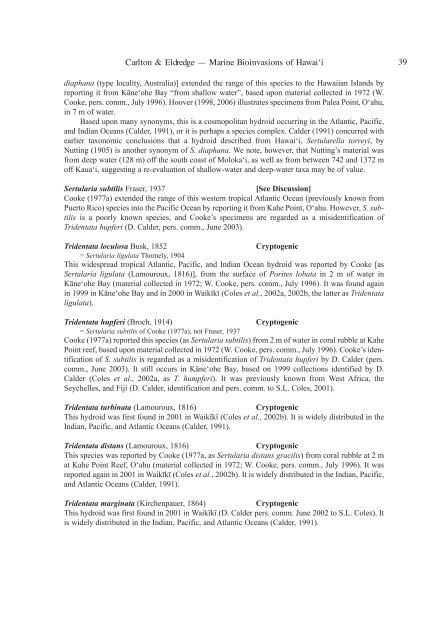bishop museum bulletins in cultural and environmental studies
bishop museum bulletins in cultural and environmental studies
bishop museum bulletins in cultural and environmental studies
Create successful ePaper yourself
Turn your PDF publications into a flip-book with our unique Google optimized e-Paper software.
Carlton & Eldredge — Mar<strong>in</strong>e Bio<strong>in</strong>vasions of Hawai‘i<br />
39<br />
diaphana (type locality, Australia)] extended the range of this species to the Hawaiian Isl<strong>and</strong>s by<br />
report<strong>in</strong>g it from Kāne‘ohe Bay “from shallow water”, based upon material collected <strong>in</strong> 1972 (W.<br />
Cooke, pers. comm., July 1996). Hoover (1998, 2006) illustrates specimens from Palea Po<strong>in</strong>t, O‘ahu,<br />
<strong>in</strong> 7 m of water.<br />
Based upon many synonyms, this is a cosmopolitan hydroid occurr<strong>in</strong>g <strong>in</strong> the Atlantic, Pacific,<br />
<strong>and</strong> Indian Oceans (Calder, 1991), or it is perhaps a species complex. Calder (1991) concurred with<br />
earlier taxonomic conclusions that a hydroid described from Hawai‘i, Sertularella torreyi, by<br />
Nutt<strong>in</strong>g (1905) is another synonym of S. diaphana. We note, however, that Nutt<strong>in</strong>g’s material was<br />
from deep water (128 m) off the south coast of Moloka‘i, as well as from between 742 <strong>and</strong> 1372 m<br />
off Kaua‘i, suggest<strong>in</strong>g a re-evaluation of shallow-water <strong>and</strong> deep-water taxa may be of value.<br />
Sertularia subtilis Fraser, 1937<br />
[See Discussion]<br />
Cooke (1977a) extended the range of this western tropical Atlantic Ocean (previously known from<br />
Puerto Rico) species <strong>in</strong>to the Pacific Ocean by report<strong>in</strong>g it from Kahe Po<strong>in</strong>t, O‘ahu. However, S. subtilis<br />
is a poorly known species, <strong>and</strong> Cooke’s specimens are regarded as a misidentification of<br />
Tridentata hupferi (D. Calder, pers. comm., June 2003).<br />
Tridentata loculosa Busk, 1852<br />
Cryptogenic<br />
= Sertularia ligulata Thornely, 1904<br />
This widespread tropical Atlantic, Pacific, <strong>and</strong> Indian Ocean hydroid was reported by Cooke [as<br />
Sertularia ligulata (Lamouroux, 1816)], from the surface of Porites lobata <strong>in</strong> 2 m of water <strong>in</strong><br />
Kāne‘ohe Bay (material collected <strong>in</strong> 1972; W. Cooke, pers. comm., July 1996). It was found aga<strong>in</strong><br />
<strong>in</strong> 1999 <strong>in</strong> Kāne‘ohe Bay <strong>and</strong> <strong>in</strong> 2000 <strong>in</strong> Waikīkī (Coles et al., 2002a, 2002b, the latter as Tridentata<br />
ligulata).<br />
Tridentata hupferi (Broch, 1914)<br />
Cryptogenic<br />
= Sertularia subtilis of Cooke (1977a), not Fraser, 1937<br />
Cooke (1977a) reported this species (as Sertularia subtilis) from 2 m of water <strong>in</strong> coral rubble at Kahe<br />
Po<strong>in</strong>t reef, based upon material collected <strong>in</strong> 1972 (W. Cooke, pers. comm., July 1996). Cooke’s identification<br />
of S. subtilis is regarded as a misidentification of Tridentata hupferi by D. Calder (pers.<br />
comm., June 2003). It still occurs <strong>in</strong> Kāne‘ohe Bay, based on 1999 collections identified by D.<br />
Calder (Coles et al., 2002a, as T. humpferi). It was previously known from West Africa, the<br />
Seychelles, <strong>and</strong> Fiji (D. Calder, identification <strong>and</strong> pers. comm. to S.L. Coles, 2001).<br />
Tridentata turb<strong>in</strong>ata (Lamouroux, 1816)<br />
Cryptogenic<br />
This hydroid was first found <strong>in</strong> 2001 <strong>in</strong> Waikīkī (Coles et al., 2002b). It is widely distributed <strong>in</strong> the<br />
Indian, Pacific, <strong>and</strong> Atlantic Oceans (Calder, 1991).<br />
Tridentata distans (Lamouroux, 1816)<br />
Cryptogenic<br />
This species was reported by Cooke (1977a, as Sertularia distans gracilis) from coral rubble at 2 m<br />
at Kahe Po<strong>in</strong>t Reef, O‘ahu (material collected <strong>in</strong> 1972; W. Cooke, pers. comm., July 1996). It was<br />
reported aga<strong>in</strong> <strong>in</strong> 2001 <strong>in</strong> Waikīkī (Coles et al., 2002b). It is widely distributed <strong>in</strong> the Indian, Pacific,<br />
<strong>and</strong> Atlantic Oceans (Calder, 1991).<br />
Tridentata marg<strong>in</strong>ata (Kirchenpauer, 1864)<br />
Cryptogenic<br />
This hydroid was first found <strong>in</strong> 2001 <strong>in</strong> Waikīkī (D. Calder pers. comm. June 2002 to S.L. Coles). It<br />
is widely distributed <strong>in</strong> the Indian, Pacific, <strong>and</strong> Atlantic Oceans (Calder, 1991).
















